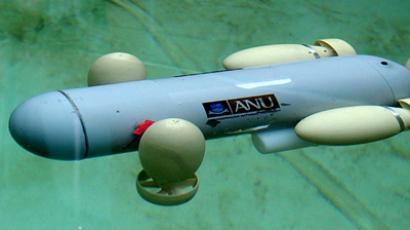DARPA goes deep: New Hydra project to see underwater drones deploying drones

The sky is no longer the limit for US drone warfare, with secret military research agency DARPA considering a conquest of the seven seas with an underwater drone carrier.
America’s Defense Advanced Research Projects Agency (DARPA) recently held a presentation of its new Hydra unmanned underwater drone carrier project at John's Hopkins University Applied Physics Laboratory. ‘Proposer’s Day’ was set to beef up interest from defense contractors.
“The Hydra program will develop and demonstrate an unmanned undersea system, providing a novel delivery mechanism for insertion of unmanned air and underwater vehicles into operational environments,” says the Hydra Proposers' Day website.
In order to tout military contractors, DARPA’s Tactical Technology Office (TTO) envisages that their Hydra unmanned submarine carrier would use “modular payloads within a standardized enclosure to enable scalable, cost-effective deployment of rapid response assets.”
Hydra network is expected to be capable of deploying both the unmanned underwater vehicles (UUVs) and ‘conventional’ unmanned aircraft (UAVs), notably all of that remaining submerged. Also DARPA engineers consider developing for the submersible a special capsule for stealth underwater transportation of troops.
“The rising number of ungoverned states, piracy, and proliferation of sophisticated defenses severely stretches current resources and impacts the nation’s ability to conduct special operations and contingency missions,” DARPA’s proposal paper maintains.
In broader terms, the Hydra project implies building an underwater drone fleet to ensure surveillance, logistics and offensive capabilities at any given time globally, throughout the world’s oceans, including shallow waters and probably any river deltas or systems.
“The climate of budget austerity runs up against an uncertain security environment," said Hydra program manager Scott Littlefield in a media release. "An unmanned technology infrastructure staged below the ocean’s surface could relieve some of that resource strain and expand military capabilities in this increasingly challenging space.”
DARPA’s gadget gurus believe they’ll have a functional demo of an underwater Hydra drone network by 2018, in case they find sufficient funding.
This all sounds sci-fi, yet drones deploying drones could be the future of unmanned warfare. Concurrently with the Hydra project, DARPA is developing a similar program with Lockheed Martin aimed at developing unmanned vehicles and drones to supply troops by air and land.
Last January DARPA also announced another program exploring an upward falling payloads (UFPs) concept, implying storage of necessary supplies on seabed in waterproof containers. Yet the UFP and Hydra are two separate projects, a DARPA spokesman stressed.
“The basic difference is that UFP involves systems deployed at the bottom of the deep sea for years at a time, while Hydra plans for modules in shallower water that are submerged for weeks or months at a time,” he explained the difference on request from InformationWeek.
The Hydra platform might also be in demand in case of natural disasters, as drones could deliver emergency equipment close to coastline of the affected areas.
“Hydra will integrate existing and emerging technologies in new ways to create an alternate means of delivering a variety of payloads close to the point of use,” informs DARPA, which eyes the not-so-remote future primarily through the prism of military application of innovative technology.
With all the technological ambitions in hand, DARPA may soon be
seen setting Guillermo del Toro’s movie ‘Pacific Rim’ as
benchmark. In any case, surfers in, say, 2020, will have to act
with discretion. Who knows what will be watching them from
underneath.













